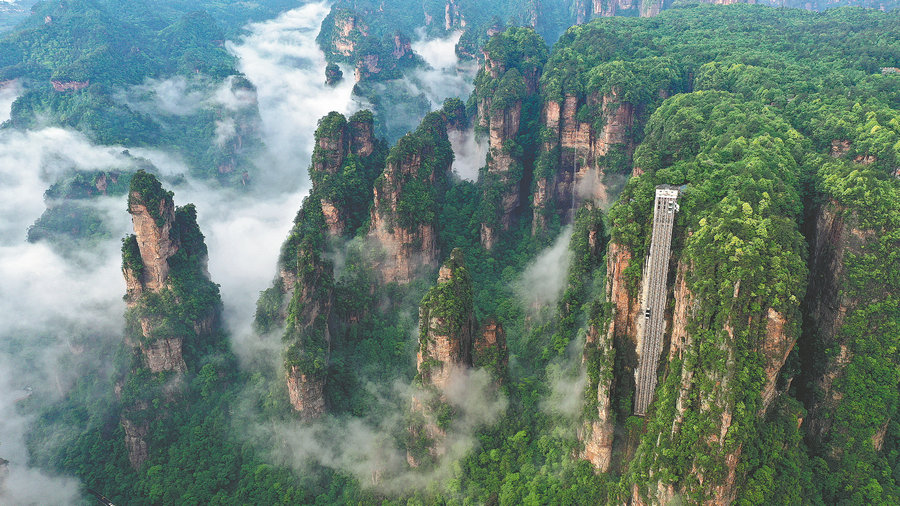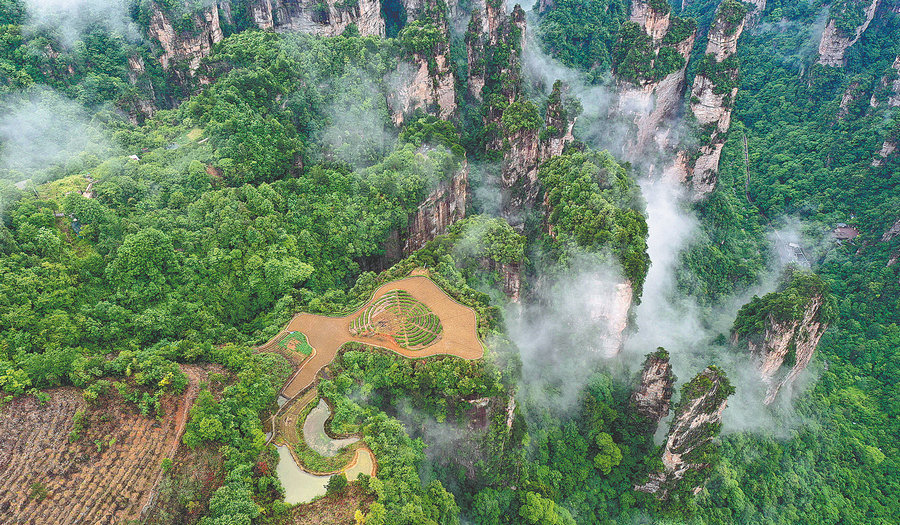
Wulingyuan Scenic and Historic Interest Area, a UNESCO World Natural Heritage Site in Hunan province, boasts more than 3,000 narrow sandstone pillars and peaks, all clad in lush vegetation.
Having committed himself to the same territory since 1994, 55-year-old Peng Shiwen has become very familiar with the terrain he safeguards.
As a ranger of the State-owned Zhangjiajie forest farm in Hunan province, his daily routine includes patrolling the secluded wood-covered mountains and staying vigilant for signs of fire.
"After all these years, I've grown accustomed to my simple life in the forest farm and formed a deep emotional connection with it. I consider the forest ranger station as my home and green mountains and woods as my companions," he says.
Peng recalls that in the past, he had to communicate with other rangers with a walkie-talkie or face-to-face, but nowadays, thanks to new technology, they're able to use smartphones and update their patrol trails and work logs in an app.
"Our working conditions are much better, with tools such as drones that patrol specific areas regularly and plan routes. We do manual patrol every day and focus on forest fire prevention and safeguarding against pine wilt disease," he says.
The forest farm is part of the Wulingyuan Scenic and Historic Interest Area, which was inscribed as a UNESCO World Natural Heritage Site in 1992. It meets the criteria for the assessment of outstanding universal value — "containing superlative natural phenomena or areas of exceptional natural beauty and aesthetic importance".
A spectacular area stretching over 26,000 hectares, the site is dominated by more than 3,000 narrow sandstone pillars and peaks, many over 200 meters high.
In addition to the striking beauty of the landscape, the region is also noted for the fact that it is home to a number of endangered plant and animal species.
Li Wei, an official from the administrative bureau of Wulingyuan Scenic and Historic Interest Area, says they're using a forest-fire early warning system, with high-altitude thermal imaging cameras to identify smoke or fire and a 24/7 control center to quickly respond to any emergencies.
To protect against pine wilt disease, they regularly clear dead pine trees to eliminate the threat of the epidemic.
"Each forest ranger is in charge of patrols of a specific region. The tradition of forest protection has been passed down through the generations. Our careful protection has achieved positive results, with good quality water and air, and conservation of wild flora and fauna," Li says.

An aerial view of farming fields nestled in the depth of mountains in Wulingyuan area. [Photo by Wu Yongbing/For China Daily]
Heritage preservation
In January 2001, the Hunan provincial authorities implemented the regulations for the protection of Wulingyuan World Natural Heritage Site, which have been revised several times.
Ecological migration and relocation in scenic areas have always been the primary challenges in the coordinated protection and development of the Wulingyuan area.
Between 1999 and 2001, Wulingyuan initiated two large-scale ecological migration and relocation projects, moving residents from the core scenic area and demolishing a total of 235,000 square meters of buildings and structures.
In May 2017, the local government issued an announcement for the third project, which is still ongoing, involving 3,087 residents and 185,100 sq m of housing.
"Wulingyuan has attached great importance to heritage conservation," says Hu Xinhua, former director of the protection office of Wulingyuan World Natural Heritage property.
"We've demolished buildings in the scenic area that violated the regulations or had a negative impact on the intrinsic value of natural heritage."
The government has also relocated noncompliant reception facilities out of the core scenic area, as well as the people involved. Now, there are no overnight services in the core area.
According to Hu, if there are construction projects, all building materials must be approved before entering the core region.
"We've put in significant efforts to protect heritage resources in Wulingyuan. Thanks to years of preservation, the lush and green hills clothed in wild profusions of vegetation are more beautiful," he says.
He says that as heritage preservation is an ongoing effort, it's necessary to improve the organizational structure to ensure a long-lasting national mechanism for sustained efficiency.

Sanitation workers clean up garbage on steep cliffs at Wulingyuan scenic area in Hunan province. [Photo by Deng Daoli/China Daily]
He calls for more financial support from the central government because it's not easy for the local government to balance heritage preservation and economic development. They sometimes have to rely on future development to provide the funds needed for protection, but the investment in protection is high.
Hu also suggests that education about the uniqueness of Wulingyuan should start from kindergarten, exerting an invisible, formative influence on local younger generation. It will raise their awareness of protecting the natural environment and resources.
"Tour guides play a crucial role as ambassadors for Wulingyuan, and they should promote the heritage value. For example, they can improve their knowledge via training, and incorporate more heritage-related content to tour guide speeches, ensuring that visitors have an overall understanding of Wulingyuan," he says.
The International Union for Conservation of Nature's World Heritage Outlook assessed Wulingyuan as of "significant concern" in 2014, noting that its outstanding universal value was threatened by the development of tourism facilities, roads, and increased visitation.
Since then, Wulingyuan started to put more efforts into prioritizing preservation, and in 2020, the IUCN World Heritage Outlook assessed it as "good with some concerns".














